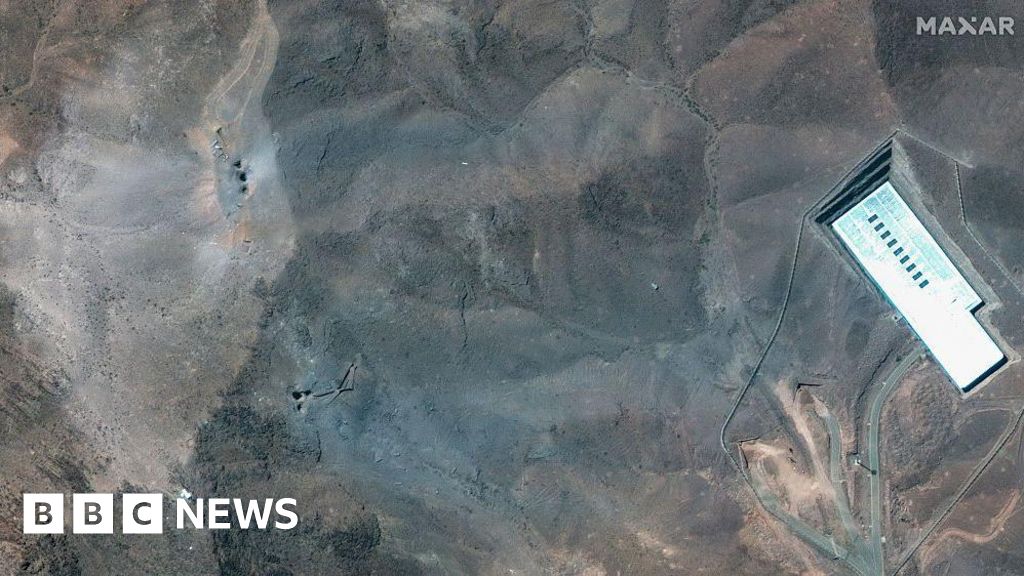American strikes did not destroy Iranian nuclear facilities: Pentagon evaluation
American strikes on Iranian nuclear establishments did not destroy the country’s nuclear program and may only restore it, according to the Early Pentagon Intelligence Assessment of the attack.
The Islamic Republic store in the enriched uranium in the bombings has not been eliminated, sources informed by an evaluation by the US BBC’s defense intelligence agency CBS.
The White House said that assessing the initial damage was “wrong” and “a clear attempt to cancel” President Donald Trump.
The president said that the air strikes on Saturday “completely blurring” the Iranian nuclear enrichment facilities.
The United States struck three nuclear facilities in Iran – Fordo, Natanz and Estehan – with “Bunker Buster” bombs capable of penetrating 18 meters (60 feet) of concrete or 61 meters (200 feet) of the Earth before the explosion.
But the sources familiar with the evaluation of the Pentagon intelligence say that the centrifuges of Iran are largely “sound” and that the effect was limited to structures above the ground.
Entrances to nuclear ports were closed, some infrastructure has been destroyed or damaged, but most of the facilities, which are deep underground, were sound.
The unknown sources have told the American media that the attack is only “a few months, summits”, and that any appeal for its nuclear program may be based on the period that the country takes to dig and make reforms.
The sources also confirmed to CBS that some enriched uranium stocks in Iran were transferred before the strikes, according to the intelligence assessment.
It was believed that the huge bombing bomb of 30,000 pounds (14,000 kg) was the only weapon capable of destroying the underground nuclear enrichment facilities in Iran.
In the hours that followed Saturday’s strikes, General Dan Kane, Chairman of the Joint Staff Board of Directors, told reporters that it would take some time to assess the damage to the facilities.
But he added that “all three sites were severely damaged and destroyed.” Satellite photos showed six fresh excavations that gather around two points to enter the Fordo nuclear sites, as well as gray dust and debris.
However, it is not clear of the images, however, the amount of damage to the locations under the surface.
Hassan Abedini, Deputy Political Director of the Iranian state broadcaster, claimed that the three sites targeted by the United States had been evacuated “while it was”, and that Iran “did not suffer from a major blow because the materials have already been taken out.”
US officials, on the other hand, praised the mission as success, as well as Israeli officials.
In a statement on Tuesday, Defense Minister Beit Higseth said that “based on everything we saw – and I saw everything – our campaign bombed Iran’s ability to create nuclear weapons.”
“Anyone says that the bombs were not devastating is just an attempt to undermine the president and the successful mission,” said Higseth.
Prime Minister Benjamin Netanyahu said on Tuesday that since hostilities with Iran began on June 13, Israel has succeeded in curbing Iran’s nuclear ambitions, as well as the destruction of the missile arsenal.
“We have removed two existential threats – the threat of nuclear annihilation and the threat of genocide by 20,000 ballistic missiles,” Netanyahu said in the video releases of his office.
A report in the Saudi news port, citing an unpredictable Israeli source, said that Israel believes that most enriched uranium in Iran is buried under the rubble.
The United States has more than ten intelligence agencies, which can produce conflicting reports based on its expertise in its mission and the region. For example, the origins of the Coronavos virus remain a topic between the intelligence community.
David Albright, head of the Institute of Science and International Security and an expert in the development of secret nuclear weapons, said the damage to the American attacks will mean “it will take a lot of time, investment and energy” to restore its nuclear program.
In a post on X, Ulbright added that Iran “is under intense and observing from the United States and Israel,” and is risking more attacks if it tries to rebuild.
On Monday, Iran took revenge on the American air strikes by launching a missile attack on the air base in Qatar, which includes thousands of American forces. This attack was largely intercepted, and no injuries or injuries were reported.
Since Iran’s revenge, President Trump has been urging Israel and Iran to agree to a ceasefire. Both countries later admitted that the ceasefire is now.



